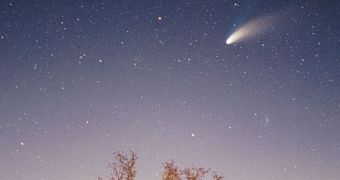Gathering and studying cometary dust is arguably one of the most difficult enterprises today, as the technology to do so is still some years away. But, in 2003, the proverbial mountain came to the scientists, in the form of an Earth-crossing comet that left behind a trail of material that got experts excited. High-flying aircraft that collected samples from the upper atmosphere returned to their bases carrying dust grains from molecular clouds in deep space, as well as materials that were part of stars that were born and died billions of years before the Sun formed. This rich trove of antiquities hints at the fact that comets are genuine, if impossible to explore, treasure troves of space history.
“We've known that many IDP [interplanetary dust particles] come from comets, but we've never been able to definitively tie a single IDP to a particular comet. The only known cometary samples we've studied in the laboratory are those that were returned from comet 81P/Wild 2 by the Stardust mission,” Carnegie Institution Department of Terrestrial Magnetism expert Larry Nittler, the co-author of the new investigation, says. Several tons of IDP enter the planet's atmosphere yearly, but connecting them to asteroids, comets or meteorites proved to be an extremely difficult process.
During the Stardust mission, the American space agency, NASA, launched a spacecraft that had the solar purpose of collecting dust left behind by comets. The robot returned home in 2006, and brought with it a wealth of samples that kept geologists and other experts busy for a long time. “What we found is that [the new samples] are very different from typical IDP. They are more primitive, with higher abundances of material whose origin predates the formation of the solar system. This is exciting because it allows us to compare on a microscopic scale in the laboratory dust particles from different comets,” Nittler explains.
The expert adds that the most likely source of the new IDP samples is the Gregg-Skjellerup comet, based on calculations of its speed, trajectory, and time of passage. Details of the studies done on the particles appear in a recent, online issue of the journal Earth and Planetary Science Letters. “We can use [IDP] as tracers for different processes that occurred in the solar system four-and-a-half billion years ago,” the scientist shares.
The largest surprise the investigators had was finding large amounts of presolar grains in the IDP samples. These are particles that were formed in stars and supernovae that died long before our solar system formed. Since then, these IDP have remained trapped here, and they can be found on meteorites, comets, as well as in the average space particles that enter the Earth's atmosphere yearly. “In the IDP associated with comet Gregg-Skjellerup they are up to the percent level. This is tens of times higher abundances than we see in other primitive materials,” Nittler concludes.

 14 DAY TRIAL //
14 DAY TRIAL //